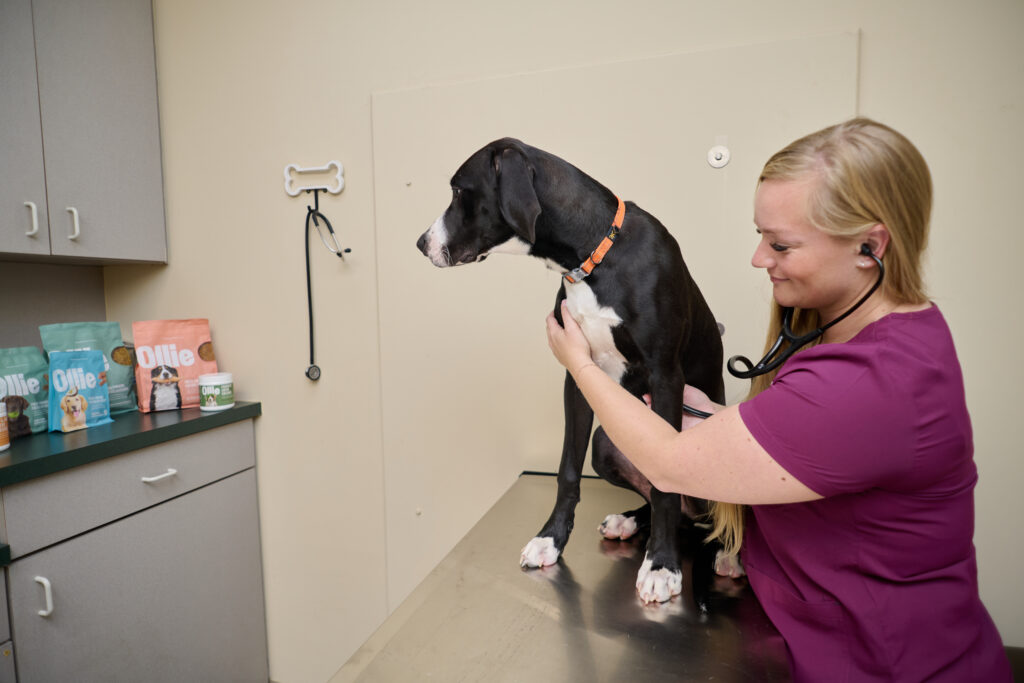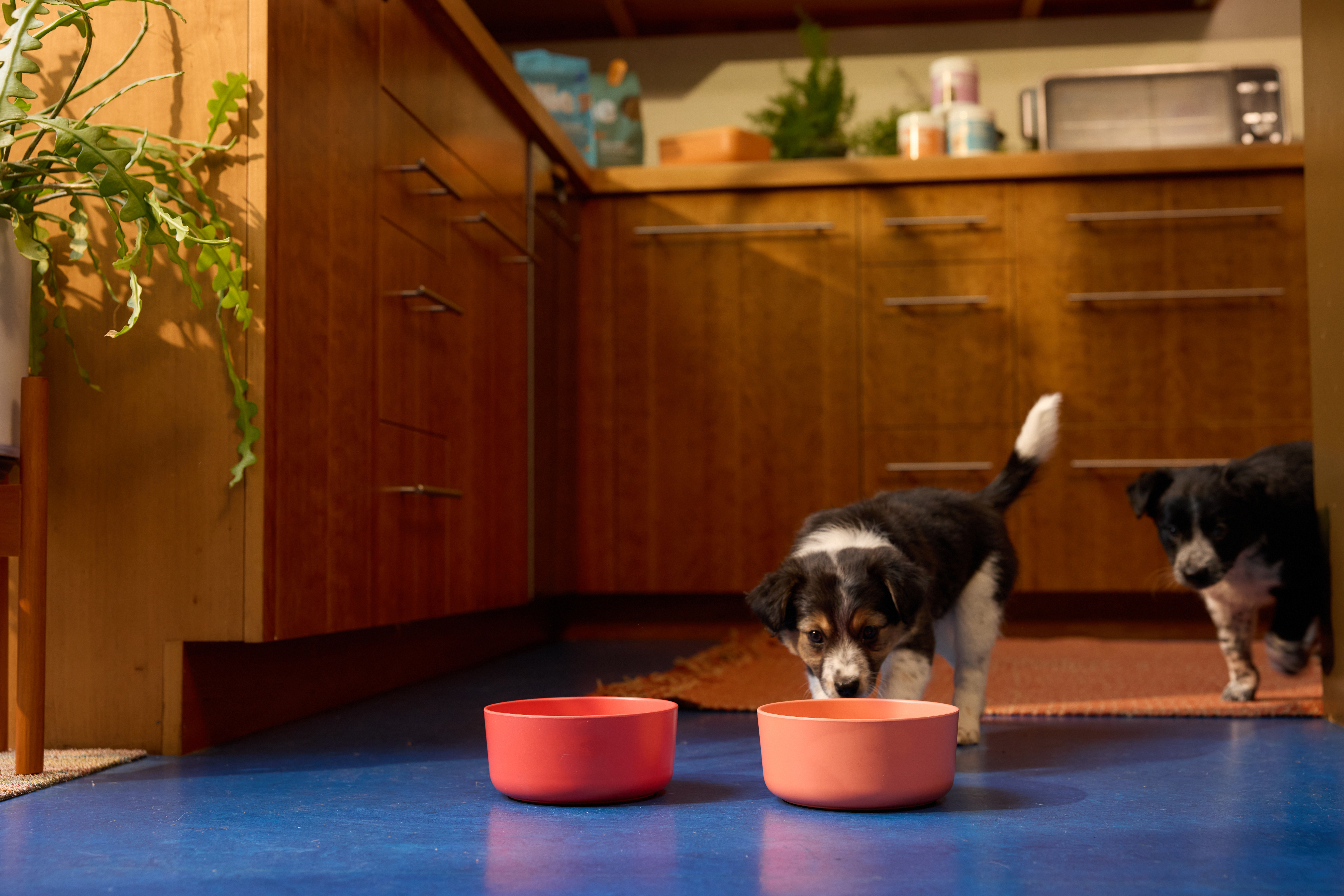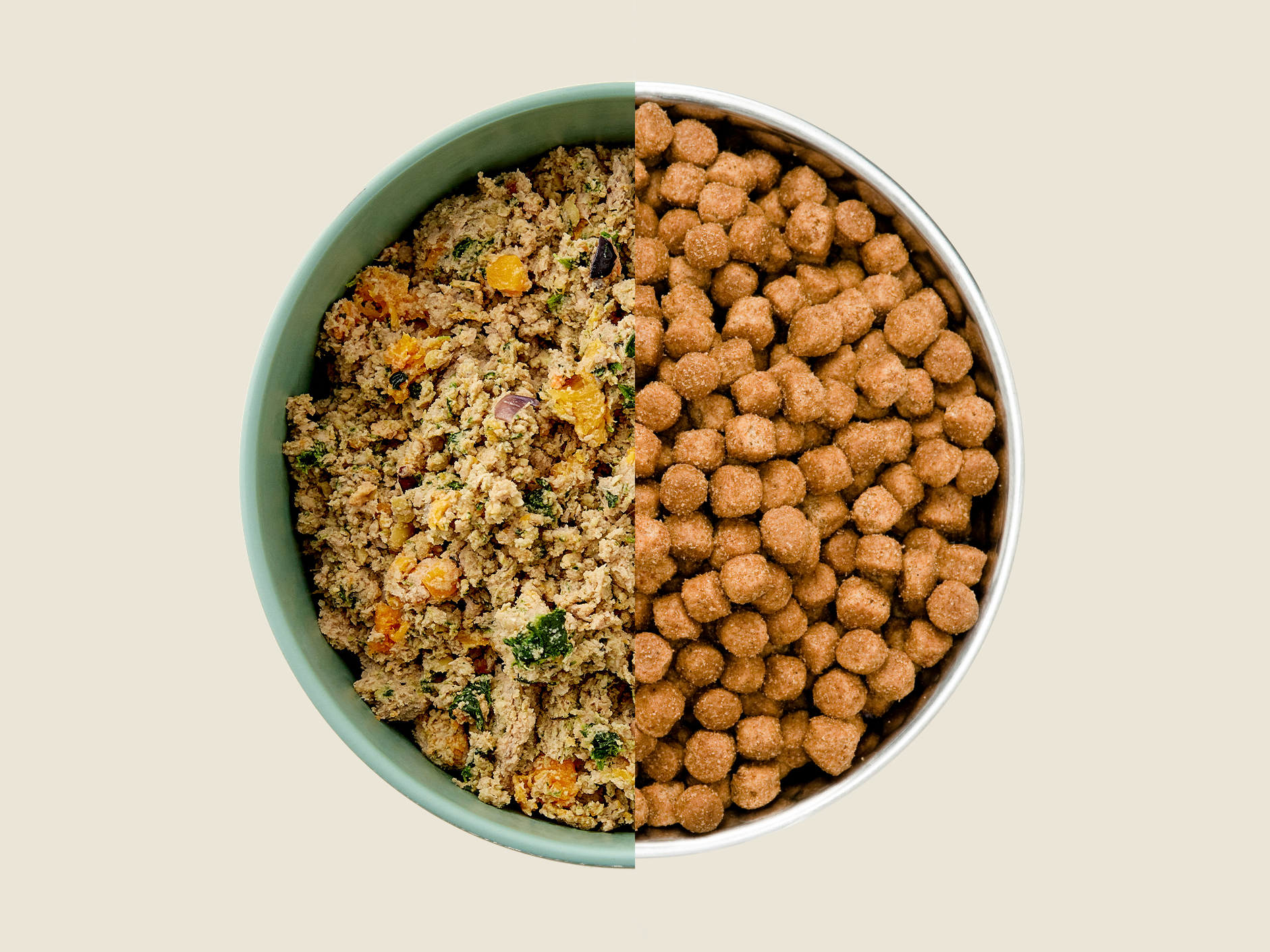Hey Ollie blog readers! We’re offering you an exclusive 60% OFF your starter box! Try now!
There’s nothing more difficult than seeing your dog uncomfortable. Constant scratching, upset stomachs, or chronic ear infections can be signs that something in their diet isn’t agreeing with them. Trying to find a solution can feel overwhelming, but you’re not alone. Specialized diets can be a way to provide relief, providing targeted nutrition to help your pup feel their best.
This article will give you the scoop on understanding the signs of food allergies and sensitivities, exploring the different types of specialized diets, and choosing the best, healthiest alternative food option for your dog.
Is It an Allergy or a Sensitivity?
First, it’s helpful to understand the difference between a food allergy and a food sensitivity. While the terms are often used interchangeably, they are distinct conditions.
- A food allergy is an immune system response to a specific ingredient, usually a protein. Your dog’s body mistakenly identifies the protein as a threat, triggering an allergic reaction. Symptoms often manifest in the skin.
- A food sensitivity or intolerance is a digestive issue. Your dog’s gut has trouble breaking down a certain ingredient, leading to gastrointestinal upset.
Common signs of a food allergy include:
- Itchy skin (pruritus)
- Excessive licking, especially of the paws
- Chronic ear infections
- Hives or skin rashes
- Vomiting or diarrhea
Common signs of a food sensitivity include:
- Gas and bloating
- Loose stools or diarrhea
- Vomiting
- Lack of appetite

Identifying the Culprit: The Elimination Diet
The most reliable way to diagnose a true food allergy is through a veterinarian-supervised elimination diet [1]. This process is considered the “gold standard” because it systematically removes potential allergens to pinpoint the exact cause of your dog’s symptoms.
Here’s how it works:
- Consult Your Vet: Before starting, talk to your veterinarian. They can rule out other medical issues and recommend the best type of hypoallergenic diet for the trial.
- Start a Strict Diet: For 8 to 12 weeks, you will feed your dog a special hypoallergenic diet. This diet will contain either a novel protein (one your dog has never eaten) or a hydrolyzed protein (a protein broken down into tiny particles that the immune system can’t recognize) [2].
- Be Consistent: During this trial period, your dog cannot have anything else—no treats, no table scraps, no flavored supplements or medications—unless approved by your vet. Consistency is crucial for an accurate diagnosis [2].
- Monitor Symptoms: It can take the full 8 to 12 weeks for allergy symptoms, especially skin inflammation, to fully resolve [3].
- The Food Challenge: If your dog’s symptoms improve, your vet will guide you through reintroducing old ingredients one at a time. If symptoms return after reintroducing an ingredient, you’ve found your culprit.
Types of Specialized Diets for Dogs
Once you and your vet have a better understanding of your dog’s needs, you can explore different types of specialized food.
Limited Ingredient Diets (LID)
Limited ingredient diets are formulated with a single source of animal protein and a minimal number of other key ingredients. The simple formula reduces the likelihood of your dog encountering an ingredient that triggers a reaction. These diets are a popular choice for dogs with both allergies and sensitivities [4]. However, be aware that retail LIDs may carry a risk of cross-contamination from other ingredients made in the same facility [1].
Novel Protein Diets
A novel protein is a protein source that your dog has not been exposed to before. Common novel proteins include venison, rabbit, duck, and salmon [5]. Because your dog’s immune system has never encountered these proteins, it’s less likely to have an allergic reaction to them.
Hydrolyzed Protein Diets
Often prescribed by veterinarians for elimination trials, hydrolyzed protein diets contain proteins that have been chemically broken down into microscopic pieces. These amino acid chains are so small that the immune system doesn’t detect them as allergens, preventing a reaction [2].
Fresh and Raw Diets
Fresh, human-grade and raw diets are gaining popularity as healthy dog food alternatives, especially for pups with sensitive stomachs. These diets focus on high-quality, whole-food ingredients that are minimally processed. This approach avoids common irritants like fillers, artificial additives, and preservatives that can trigger sensitivities [6].
Some fresh food services offer recipes formulated with veterinary nutritionists using human-grade meats, fruits, and vegetables. The meals are gently cooked to preserve nutrients and maximize digestibility. Because the plans can be customized to your dog’s specific profile—including any known allergies—it’s an easy way to provide a limited-ingredient, high-quality diet without the guesswork.

Key Ingredients to Look For (and Avoid)
When comparing dog foods, the ingredient list is your best friend.
What to Look For
- Highly Digestible Proteins: Lean proteins like turkey, lamb, and fish are often easier on a dog’s digestive system [4].
- Prebiotics and Fiber: Ingredients like pumpkin and sweet potatoes provide fiber and prebiotics, which feed the good bacteria in your dog’s gut.
- Probiotics: Live, beneficial bacteria that support gut health and a balanced microbiome [7].
- Omega Fatty Acids: Omega-3 and omega-6 fatty acids, often from fish oil or flaxseed, help support healthy skin and a shiny coat, which is especially beneficial for dogs with skin allergies [5].
- “Complete and Balanced” Label: Ensure the food meets the nutritional standards set by the Association of American Feed Control Officials (AAFCO) [8].
What to Avoid
- Artificial Additives: Avoid artificial colors, flavors, and preservatives, which can cause reactions in sensitive dogs [4].
- Common Fillers: Fillers like corn, wheat, and soy provide little nutritional value and are common culprits for sensitivities [5].
- Meat By-Products: This vague term can refer to low-quality parts of an animal. Opt for foods with named, whole-meat sources instead.
- High-Fat Content: Diets that are very high in fat can be difficult for some dogs to digest and may trigger gastrointestinal upset [5].
Making the Switch: A Gradual Transition
When you find a new food for your dog, it’s important to transition them slowly. Switching food too quickly can worsen digestive issues like diarrhea and vomiting. A gradual transition gives your dog’s system time to adjust.
Follow this simple 7-to-10-day plan:
- Days 1–3: 75% old food, 25% new food
- Days 4–6: 50% old food, 50% new food
- Days 7–9: 25% old food, 75% new food
- Day 10: 100% new food
A Pet Parent’s Story
“Our French Bulldog, Gus, was constantly scratching and had terrible gas. We tried so many different kibbles, but nothing worked. After switching to a limited-ingredient lamb recipe, the change was incredible. His scratching stopped completely, his digestion improved, and he just seems so much happier. We finally found a healthy alternative that works for his sensitivities!”
Partnering in Your Dog’s Health
Finding the right food for a dog with allergies or a sensitive stomach is a journey, but it’s one of the most impactful things you can do for their long-term health and happiness. By working with your veterinarian, understanding ingredient labels, and choosing a high-quality, digestible diet, you can provide immense relief for your companion.
Whether you opt for a veterinary diet, a limited-ingredient kibble, or a fresh food service, the goal is the same: a happy, comfortable dog with a diet that nourishes them from the inside out.
Ready to discover the benefits of fresh food? Find your dog’s recipe for success with Ollie.
Frequently Asked Questions (FAQs)
How long does it take to see improvement on a new diet?
For food allergies, it can take 8 to 12 weeks for skin-related symptoms to fully clear up during an elimination trial [3]. For digestive sensitivities, you may notice improvements like firmer stools or less gas within a week or two of successfully transitioning to the new food.
Can I just buy a “grain-free” food for my dog’s allergies?
While some dogs are sensitive to certain grains, food allergies are more commonly caused by proteins like beef, chicken, and dairy. A grain-free diet is not automatically hypoallergenic. The best approach is to identify your dog’s specific trigger ingredient with the help of your vet rather than just removing all grains.
What’s the difference between a food allergy and seasonal allergies?
Food allergies typically cause symptoms year-round, whereas seasonal allergies flare up during specific times of the year when allergens like pollen are high. However, the symptoms (like itchy skin) can look very similar, and some dogs can suffer from both. Your veterinarian can help you distinguish between them [2].
Are raw diets safe for dogs with sensitive stomachs?
High-quality raw diets made with minimal ingredients can be an option for dogs with sensitive stomachs because they are highly bioavailable and free from processed fillers [6]. However, it is crucial to choose a reputable brand that performs rigorous safety testing for pathogens like Salmonella and E. coli. Always consult your veterinarian before switching to a raw diet.
Citations
[1] https://vcahospitals.com/know-your-pet/food-allergies-in-dogs
[2] https://www.petmd.com/dog/general-health/food-allergies-vs-seasonal-allergies-dogs
[3] https://veterinaryskinandear.com/food-allergies-in-dogs/
[4] https://www.dogfoodadvisor.com/best-dog-foods/sensitive-stomach/
[5] https://www.splootvets.com/post/dog-food-sensitive-stomachs
[6] https://wefeedraw.com/blog/best-dog-food-for-sensitive-stomach
[7] https://www.petmd.com/dog/nutrition/bland-diet-for-dogs
[8] https://www.akc.org/expert-advice/nutrition/best-dog-food-sensitive-stomachs/
Tagged As:

The nutrition your dog needs,
the food they want.

Enjoying our articles? Subscribe our Newsletters and get new articles directly to your inbox
You might also like
4 August 2025
5 MINS READ
Key Ingredients in Fresh Dog Food Explained
The right food starts with the right ingredients. Unlike highly processed kibble, which can contain fillers and low-quality by-products, fresh food focuses on transparency and quality. At Ollie, w…
by Ollie Pets
4 August 2025
6 MINS READ
Fresh Dog Food Benefits for Growing Puppies
Proper nutrition as a puppy is the foundation for a long, healthy, and happy life. Fresh, human-grade meals can support your puppy’s rapid growth, brain development, and long-term health in ways…
by Ollie Pets
4 August 2025
5 MINS READ
Is Fresh Food Easier to Digest Than Kibble?
The right nutrition is essential in making sure your dog is living their happiest, healthiest life. A major factor in choosing the right diet is making sure your dog is able to actually use and ab…
by Ollie Pets







